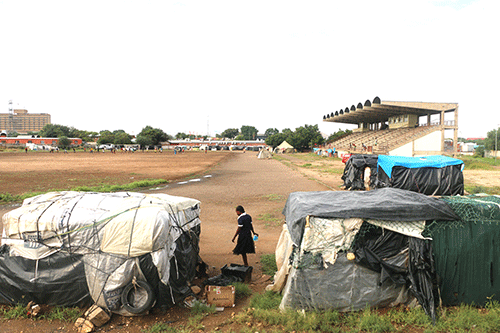The Katutura Multi-purpose Youth Centre and the field behind the Khomasdal Stadium, designated for football matches and track and field events, are currently occupied by homeless people.
Owned respectively by the Ministry of Sports, Youth and Social Services and the City of Windhoek, this centre and field have become shelters for former South West Africa Territorial Force and Koevoet soldiers and homeless people, who were relocated from the streets during Namibia’s Covid-19 lockdown and dumped at the Khomasdal field around 2019.
This comes at a time when Namibia faces challenges with limited sports infrastructure. At the youth centre’s field in Katutura, additional tents have been set up on the periphery, with residents allegedly misusing water resources, including bathing in makeshift showers.
However, some athletes still utilise the facilities for jogging, football, and boxing training.
As Namibia celebrates 34 years of Independence, New Era Sport spoke to the executive director of the Ministry of Sports Mbumba Haitengela, local sports pundit Isack Hamata and youthful boxer Harry Simon junior to assess the country’s investment in sports infrastructure, training facilities and community sports centres.
Regarding the unused or under-utilised fields, Haitengela stated that discussions are ongoing with stakeholders to find alternative housing for the displaced individuals.
“There was a strategic meeting held with different stakeholders with the purpose of discussing how best to relocate these people. The discussion is still ongoing. The issue right now is to find out where to place them. The municipality was tasked to find land. But there is a follow-up meeting slated for next week,” he stated.
Haitengela added that the latest population statistics show that more than 70% of Namibians are below the age of 35, and their mandate is thus to invest in these young people. “We need to invest in all the capital cities of Namibia’s 14 regions. Some regions are far ahead in terms of infrastructure development, while others are tailing behind. The ministry wants to put up state-of-the-art facilities”.
However, there is no talk of fixing those already available.
“Right now, football, netball and rugby are the three core codes we are looking at, and for every infrastructure built, they need to cater for it.
We also urge sports federations to come up with proper development programmes, and to work together with the Namibia Schools Sport Union because we want to revive the spirit of the youth,” Haitengela continued.
Hamata, on the other hand, shared how improved facilities can support athletes’ development, attract sporting events, and promote grassroots’ participation.
“Facilities, whether they are stadiums, training grounds or sports centres, are the tools of an athlete’s trade. That is what he or she uses to prepare for battle, to get fit physically, mentally and psychologically.
Without such infrastructure, there is little that an athlete can do, despite the enormous talent that they may have. The absence of inadequate stadiums is a drawback to athletes’ development in all manners and forms,” he stated.
Hamata said properly-equipped stadiums and training facilities provide safe and effective training environments. “These fosters better technique, reduces injury risk and attracts high-calibre coaches, propelling athletes to higher levels.
A world-class facility can attract major sporting events, bring in revenue, tourism and showcasing our country’s sporting talent on a global stage. Accessible sports centres in neighbourhoods encourage grassroots’ participation. This combats health issues, fosters social interaction, and identifies potential future stars.
Proper facilities accommodate a wider range of sports and abilities, ensuring everyone can play and enjoy the benefits of physical activity,” he continued.
Simon junior echoed these sentiments, highlighting the disparities in infrastructure across towns. “Not all the towns have the right infrastructure. You must travel to different towns to get exposed to proper training environments. There is no boxing gym now in Walvis Bay. It’s been closed since December, and yet I’ve fought internationally last week, with minimum preparation.
I was just lucky enough to have a few sponsors who made training available in towns that had gyms. But imagine the possibilities if I could train with the right resources, and at facilities which have state- of-the-art equipment,” he said. –lmupetami@nepc.com.na


